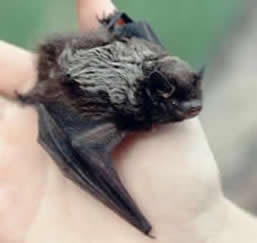

NATURE NOTES

Silver-haired Bat
(Lasionycteris noctivagans), photo by Paul D. Pratt
Here Among the Bats
by
I discovered something while at a local park with by second child, who is a very active toddler. Barn swallows are great for wearing out your children after your children have already worn you out. These birds, one of the most widespread species in the world, are fast-flying insect-eaters that dart above fields and watercourses. On farms, they swoop close to the ground around tractors and lumbering farm animals, picking off insects. They do the same thing with toddlers running across lawns. In turn, the toddler chases the pretty bird, scaring up more insects from the grass, and the swallow swoops again. The child is running and laughing as the bird flies and eaats. In the eyes of a tired dad, it is a perfect symbiotic relationship.
The evening of the same day I was a at local park with a group of people, hoping to see bats. In my hand was a bat detector, a nerdy bit of hardware that picks up the ultrasonic calls that bats use to echolocate and transforms them into audible sounds. Just as we were about to give up, it picked up the feeding call of a Big Brown Bat, which is an official species name and not the description of a bat by an unimaginative person.
After this tantalizing occurrence, there was nothing. A long nothing. We tried another spot and heard another weak call. Slightly disappointed, we went back to the parking lot. The lights were on, drawing moths and other insects. Suddenly the bat detector emitted an electronic fantasia, with trills and clicks in crazy syncopation. We were standing beneath or within a sea of circling bats, but couldn't see them anywhere.
After a while, I turned the detector off. "You would never know there are bats here," I said. I wondered how often we are in the presence of these remarkable creatures without a clue. Much as barn swallows dance around children in playgrounds by day, frantic bug-eating mammals flutter around us at night. I clicked the detector on again and the silence ripped back into an unremitting chaotic series of chirps. I then thought it might be a good thing that we cannot normally hear bats. We'd never be able to sleep.
Bats and barn swallows are airborne insectivores that for the dwindling days of summer will continue to share our world, and, when we able to notice them, make it bigger.
Hugh Griffith is a BC zoologist and science writer.
Please cite these pages as:
Author, date, page title. In: Klinkenberg, Brian. (Editor) 2023. E-Fauna BC: Electronic Atlas of the Fauna of British Columbia [www.efauna.bc.ca]. Department of Geography, University of British Columbia, Vancouver. [Date Accessed]
© Copyright 2023 E-Fauna BC.